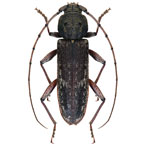Phacodes
Newman
Cerambycinae
Phacodes Newman, 1840: 7. Type species: Phacodes lentiginosus Newman, 1840.
Diagnosis
Small to medium-sized, mostly brown to dark brown beetles with antennae usually extending to or beyond elytral apices. Frontoclypeus transverse. Gland opening at base of mandibles absent. Eyes large, coarsely facetted, deeply emarginate. Antennal tubercles moderately separated, close to mandibular articulation. Antennal foramen depressed. Antennal scape slender, distinctly shorter than pronotum; pedicel transverse or as long as wide; antennomere 3 longer than scape, with apical spine. Pronotum usually about as long as wide, lateral margins arcuate, smooth; pronotal disc with low tubercles or shiny nodules. Prosternal process narrow, not expanded apically. Procoxal cavities oval with broad lateral extensions, exposing protrochantin; open externally. Procoxae projecting below prosternal process. Mesoventrite flat anteriorly. Mesocoxal cavities moderately separated medially, broadly open to mesepimeron; mesotrochantin visible. Elytra without ridges, punctures at base large, irregular, abruptly decreasing in diameter medially. Femora and tibiae not flattened.
Distribution and Biology
Phacodes is widely distributed throughout Australia with most of the species known from New South Wales, Victoria, Tasmania and South Australia. It is also recorded from Lord Howe Island.
Adults have been collected, mostly at light, from October to March. Duffy (1963) described larvae of P. mirabilis and P. longicollis collected in Argyrodendron trifoliolatum in Queensland.
Australian Species
bellus Blackburn
Phacodes bellus Blackburn, 1891: 343.
distinctus Pascoe
Phacodes distinctus Pascoe, 1865: 373.
elusus Pascoe
Phacodes elusus Pascoe, 1865: 373.
essingtoni (Hope)
Callidium essingtoni Hope, 1842: 429.
ferrugineus Pascoe
Phacodes ferrugineus Pascoe, 1864: 238.
fuscus Pascoe
Phacodes fuscus Pascoe, 1865: 373.
longicollis Pascoe
Phacodes longicollis Pascoe, 1871: 270.
marmoratus Blackburn
Phacodes marmoratus Blackburn, 1891: 344.
mirabilis McKeown
Phacodes mirabilis McKeown, 1940: 297.
modicus Blackburn
Phacodes modicus Blackburn, 1901: 31.
mossmanni Newman
Phacodes mossmanni Newman, 1850: cxxiv.
obscurus (Fabricius)
Callidium obscurum Fabricius, 1787: 151.
Phacodes lentiginosus Newman, 1840: 7.
occidentalis Blackburn
Phacodes occidentalis Blackburn, 1894: 192.
personatus Erichson
Phacodes personatus Erichson, 1842: 221.
singularis McKeown
Phacodes singularis McKeown, 1948: 51.
subfasciatus Gahan
Phacodes subfasciatus Gahan, 1893: 170.
Callidium solandri: Macleay 1826: 450.
tenuitarsis Pascoe
Phacodes tenuitarsis Pascoe, 1871: 270.
validus Blackburn
Phacodes validus Blackburn, 1891: 342.
References
Blackburn, T. 1891. Further notes on Australian Coleoptera, with descriptions of new genera and species. Part X. Transactions of the Royal Society of South Australia 14: 292–345.
Blackburn, T. 1894. Notes on Australian Coleoptera with descriptions of new species. Part XIII. Proceedings of the Linnean Society of New South Wales 2 8: 185–208.
Blackburn, T. 1901. Further notes on Australian Coleoptera with descriptions of new genera and species. Part XXVIII. Transactions of the Royal Society of South Australia 25: 15–44.
Erichson, W.F. 1842. Beitrag zur Insecten-fauna von Vandiemensland, mit besonderer Berucksichtigung der geographischen Verbreitung der Insecten. Archiv für Naturgeschichte 8(1): 83–287, pls 4, 5.
Fabricius, J.C. 1787. Mantissa insectorvm sistens species nvper detectas adiectis characteribvs, genericis, differentiis, specificis, emendationibvs, observationibvs. Tome II. Hafniae [= Copenhagen] 382 pp.
Gahan, C.J. 1893. Notes on the longicornia of Australia and Tasmania. Part I., with a list of the species collected by Mr. J. J. Walker, R.N., F.L.S., and descriptions of new forms. Transactions of the Entomological Society of London 1893: 165–197.
Hope, F.W. 1842. Observations on the Coleoptera of Port Essington, in Australia. Annals and Magazine of Natural History 1 9: 423–430.
Macleay, W.S. 1826. Annulosa, Catalogue of Insects, collected by Captain King, R.N. app. B, pp. 438–469, Table B in King, P.P. (ed.). Narrative of a survey of the intertropical and western coasts of Australia. Performed between the years, 1818 and, 1822. London: John Murray Vol. 2.
McKeown, K.C. 1940. Notes on Australian Cerambycidae V. Records of the Australian Museum 20(5): 293–312, pls XXXI, XXXII.
McKeown, K.C. 1948. Australian Cerambycidae VIII. Notes on a collection from the Western Australian Museum, with descriptions of new species. Records of the Australian Museum 22(1): 49–63.
Newman, E. 1840. Entomological notes (continued). The Entomologist 1(1): 1–16.
Newman, E. 1850. Description of two Coleopterous insects from New Holland. The Zoologist 8: appendix cxxiv.
Pascoe, F.P. 1864. Descriptions of some new Australian longicornia. Journal of Entomology 2(10): 223–245 pl. xi.
Pascoe, F.P. 1865. A second series of descriptions of new Australian longicornia. Journal of Entomology 2(12): 352–374 pl. xvi.
Pascoe, F.P. 1871. Descriptions of new genera and species of longicorns, including three new subfamilies. Annals and Magazine of Natural History 4 8(46): 268–281 pl. xiii.
